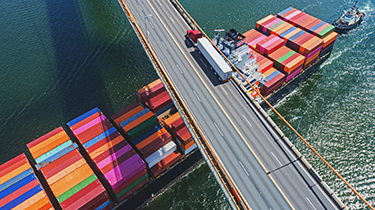In EDC Economics’ latest Top 10 global risks report, we cautioned that the current macroeconomic backdrop has increased debt vulnerabilities for many developing market governments.
While the probability of a systemic sovereign debt crisis remains low, and the vast majority of Canadian exporters tend to trade with other corporates, a wave of sovereign defaults across mid- to large-sized emerging markets would impact Canadian companies doing business in certain parts of the world. Additionally, as Canada’s exports continue to diversify into many of these faster-growing economies, sovereign creditworthiness will play a greater role in the outlook for Canadian trade.
One distinguishing factor of emerging markets is that state-linked entities tend to play an outsized role in the economy, often acting as the best domestic credit. In many markets, it can be hard to distinguish between pure private- and public-sector entities, giving way to the informal, but misleading term quasi-sovereign entity.
Varying degrees of state intervention that characterize the more dirigiste approach in some of these markets also mean that government finances can heavily influence the broader business environment. Even if you’re not doing business directly with the government of Brazil, for example, fiscal pressures in Brasília will often impact your local buyer’s ability to meet their obligations or access foreign currency.
So, what’s the outlook for sovereign risk? For starters, in recent years, government debt has been steadily rising in order to keep up with the mounting health-care costs associated with aging and increasingly wealthy populations. COVID-19 stimulus measures, increased defence spending in the wake of heighted geopolitical tensions, higher food and energy costs related to the war in Ukraine and the need to address new challenges, like climate change, have only added to these more structural trends.
You should also check out
EDC interactive tool offers economic insights on Canada’s Top 75 trading partners.
As a result, global public debt has ballooned more than fivefold since the start of the pandemic, massively outpacing global gross domestic product (GDP) growth. By 2022, global public debt hit a record US$92 trillion, with developing countries owing almost 30% of the total, the majority of which was owed by China, India and Brazil.
The sluggish growth outlook and current high interest environment has only added to financial pressures, with government balance sheets increasingly squeezed by higher debt servicing costs and weaker income growth. For those who borrow in U.S. dollars, the strength of the greenback is an additional pressure.
Like personal finances, governments can sustain themselves for a year or two by drawing down on reserves, cutting back on expenditures and taking out additional loans. But, by year three, options start to wane.
According to analysis in our Country Risk Quarterly, a growing number of countries are beginning to face varying levels of debt distress. While last year we saw the defaults of several frontier markets, like Sri Lanka, El Salvador, and Ghana, risks have now increased in some larger economies, including Egypt and Pakistan. This shift is reflected in EDC Economics’ country ratings, where there’s been a sharp increase in the number of countries at high risk of default over the next few years.
So, what do sovereigns do when they’re under financial duress? Typically, they’ll look to restructure their obligations with creditors, seeking either a haircut in the nominal value of the loan or an extension of the repayment terms. They’ll also turn to official creditors, like the International Monetary Fund (IMF), the World Bank and the Paris Club of bilateral creditors, seeking similar reschedulings or outright debt cancellation.
More recently, the process has become more protracted, as the composition of creditors has changed. China, not a formal member of the Paris Club, is now the world’s largest sovereign lender to developing economies, with its own approach and set of priorities. Governments have also increasingly turned to international capital markets to bridge their financing gaps, and often on terms significantly less generous than those offered by official creditors.
The bottom line?
Although sovereign credit risk is rising, and the ability to deal with those in debt distress is even more complex, we don’t anticipate a systemic sovereign debt crisis on the horizon. For all the concerns, developing economies are in better shape than they were back in the mid-1990s, the last time we experienced a wave of sovereign defaults. But for Canadian exporters, keeping a closer eye on public finances will help balance the risks and tremendous opportunities of doing business in fast growing corners of the world.
This week, a very special thanks to Ian Tobman, manager of our Economic and Political Intelligence Centre.
As always, at EDC Economics, we value your feedback. If you have ideas for topics that you would like us to explore, please email us at economics@edc.ca and we’ll do our best to cover them.
This commentary is presented for informational purposes only. It’s not intended to be a comprehensive or detailed statement on any subject and no representations or warranties, express or implied, are made as to its accuracy, timeliness or completeness. Nothing in this commentary is intended to provide financial, legal, accounting or tax advice nor should it be relied upon. EDC nor the author is liable whatsoever for any loss or damage caused by, or resulting from, any use of or any inaccuracies, errors or omissions in the information provided.







